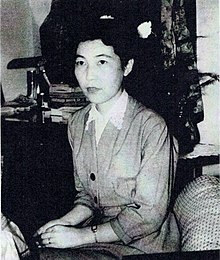Yoshiko Shibaki
Yoshiko Shibaki | |
|---|---|
芝木好子 | |
 | |
| Born | May 7, 1914 Tokyo |
| Died | August 25, 1991 (aged 77) |
| Nationality | Japanese |
| Occupation | Novelist |
Notable work | "Seika no Ichi", "Sumidagawa boshoku" |
Yoshiko Shibaki (芝木好子) (May 7, 1914 – August 25, 1991) was a Japanese novelist. She became the second woman to win the Akutagawa Prize in 1941.
Early life and education[]
Shibaki was born in Tokyo on May 7, 1914. Her family was wealthy, and moved to Asakusa when Shibaki was a child. She grew up trained in traditional Japanese arts like tea ceremony, writing poetry, and painting. Her parents also took her to see kabuki plays.[1] She began writing after her father's death in 1932 as a way of dealing with her grief. Her mother died soon afterward in 1935.[2] She married economist in 1941.[1]
Career[]
Shibaki began contributing to literary magazines in 1933. Fumiko Hayashi began mentoring her in 1936. She won the Akutagawa Prize in 1941 for her short story "Seika no ichi" (青果の市). She was the second woman to win the award.[2] In 1943 the government sent Shibaki to Manchuria to write about Japanese settlements there. She wrote two books about this trip, and continued writing throughout World War II, though she didn't publish. After the war, she published the stories she wrote during the war in quick succession. In 1956, Shibaki visited Southeast Asia with Ayako Sono, Tsuyako Miyake, and Shigeko Yuki.[1]
She became a member of the Japan Art Academy in 1980, and won their award for the literary arts in 1981.[2] Her novel Sumidagawa boshoku (隅田川暮色) won the Shincho Literary Prize and the Nihon Literature prize.[2]
Shibaki died of breast cancer on August 25, 1991.[3]
Style[]
While Shibaki wrote frequently about childhood and nostalgic topics during her early career, during the 1950s she began writing about prostitutes. She was inspired by media coverage of activists like Taiko Hirabayashi and Ichiko Kamichika, who were working to pass the Prostitution Prevention Law. After her trip to Southeast Asia, she became writing longer stories and became closer to her protagonists.[1] Her stories usually includes two people, one older and one younger, and focuses on the way they interact.[2]
Selected bibliography[]
Short stories[]
- Seika no ichi (青果の市), 1941
- Yuba (湯葉), 1960
- Kazahana (風花), 1970
Novels[]
- Yoru no tsuru (夜の鶴), 1964
- Katsushika no onna (葛飾の女), 1965
- Asu o shirazu (明日を知らず), 1968
- Kiiroi Kotei (黄色い皇帝), 1976
- Onna no shozo (女の肖像), 1979
- Sumidagawa boshoku (隅田川暮色), 1984
- Susaki no onna (洲崎の女), 1994
References[]
- ^ Jump up to: a b c d Japanese women writers : a bio-critical sourcebook. Mulhern, Chieko Irie. Westport, Conn.: Greenwood Press. 1994. ISBN 0-313-25486-9. OCLC 29848281.CS1 maint: others (link)
- ^ Jump up to: a b c d e Schierbeck, Sachiko Shibata. (1994). Japanese women novelists in the 20th century : 104 biographies, 1900-1993. Edelstein, Marlene R. [Copenhagen]: Museum Tusculanum Press. ISBN 87-7289-268-4. OCLC 32348453.
- ^ "芝木好子". Kotobank.
- 1914 births
- 1991 deaths
- Japanese women novelists
- Winners of the Akutagawa Prize
- People from Tokyo